Edible honeysuckle began to appear in Russian gardens in the middle of the last century, but is still considered an exotic plant. According to descriptions of edible honeysuckle varieties and reviews from gardeners, this is the earliest of all temperate climate berries and one of the most winter-hardy berry crops.
|
Edible honeysuckle is a species of the genus Honeysuckle of the Honeysuckle family. Deciduous shrub up to 2 m tall.Flowering time: May - early June. According to the ripening period, varieties are divided into: early, mid-ripening, and late. |
| Content:
|
Blue honeysuckle bushes with tasty edible fruits are found in the wild in the forests of the Urals, Siberia and the Far East. Cultivated edible varieties of honeysuckle are bred from Kamchatka honeysuckle and Edible honeysuckle, have high winter hardiness and can withstand frosts down to -50°C in winter and frosts down to -7°C during flowering.
Honeysuckle is a self-sterile crop; in order to bear fruit, it needs pollinating varieties. There are varieties that are partially self-fertile, but without neighboring pollinators, their yield is much less.
|
For cross-pollination, it is necessary to select varieties with the same flowering periods and different ripening periods. |
Edible honeysuckle berries contain large amounts of glucose, fructose, and sucrose. It has medicinal properties and is used in folk medicine and cooking. Sometimes edible honeysuckle is grown as an ornamental plant.
Frost-resistant varieties for the Moscow region and the middle zone
When selecting planting material, keep in mind that one bush will not give a good harvest; group plantings of at least 3 different varieties of bushes are necessary.
Fire opal
|
The variety is characterized not only by high frost resistance, but also by its versatility and good transportability. |
The taste rating of the berries is 4.5 points. The fruits retain their nutritional value for a long time.
- Average ripening period, in the second half of May.
- The first flowering occurs in the 4th year of growth.
- The yield is high, 4-6 kg per bush.
- The average weight of the berries is 1.2 g. The shape is wide oval up to 1.6 cm in length. The berries do not fall off after ripening and do not burst when picked.The pulp is dense, juicy, sweet and sour. If there is insufficient lighting, a slight bitterness may appear in the taste.
- The height of the bush is 1.5 m. The shoots are straight, medium thick.
- Frost resistance is high. The variety is recommended by the State Register for cultivation throughout Russia.
- Pollinator varieties: Morena, Kamchadalka, Blue spindle.
Review from Zinaida Rozanova, 50 years old, Novosibirsk
I have several varieties of honeysuckle on my property, including Fire Opal. One of the best varieties for making homemade wine. The crop is early-fruiting, does not require special care other than pruning, and overwinters well without shelter. There have been no problems with diseases; I treat pests with copper sulfate in the spring and autumn.
Altair
|
Bush with a dense and squat crown. The berries do not fall off for a long time and remain on the plant until they are harvested. |
Taste rating: 4.4 points. The variety is not susceptible to diseases and pests. Suitable for industrial cultivation.
- Medium ripening variety, mid-June.
- The first flowering occurs 3 years after planting.
- The maximum yield at an average level is 2.5-3 kg.
- The weight of the berries is 1 g, the skin is blue-blue. The taste is sweet and sour, refreshing, with a slight tartness.
- Bush with a rounded crown, 1.5 m high.
- Frost resistance is high. The variety is recommended by the State Register for cultivation in Russia.
- Pollinator varieties: Morena, Blue spindle.
Review from Tamara Lisitsyna, 42 years old, Abakan
I have had honeysuckle Fire Opal at my dacha for more than seven years now, I have 4 bushes of this variety and 2 Kamchadalkas, they serve each other well as pollinators. I always reap a high harvest.
Blue spindle
|
The variety is characterized by high yield, good resistance to frost and drought, as well as to diseases and pests. |
The disadvantage of this variety of honeysuckle is that after ripening the berries quickly fall off. Universal application. Taste qualities are rated 3.7 points.
- Mid-early ripening period, June 12-23.
- The bush begins to bear fruit in the 4th year.
- Maximum yield is 2.1 kg per plant.
- The average weight of the berries is 0.9 g. The taste of the fruit is sweet and sour with bitterness.
- The height of the bush is 0.9-1.3 m. The bush is compact, with a loose crown.
- Tolerates frosts of -40°C without consequences.
- Pollinator varieties: Zolushka, Kamchadalka, Lazurnaya, Blue Bird, Tomichka, Pamyati Gidzyuk.
Review from Svetlana, 49 years old, Ekaterinburg
I have been doing honeysuckle for a long time. The following varieties grow on my site: Blue Spindle, Kamchadalka, Tomichka and Zolushka. All plants have tasty berries: I make jam and grind them with sugar. I fully provide my family with vitamins for the winter.
Long-fruited
|
Winter-hardy, shatter-resistant variety with excellent taste. Universal purpose. |
- Early ripening, June 10-20.
- It begins to bear fruit 2–3 years after planting in the ground.
- Productivity 1.4-3 kg per bush.
- The weight of the berries is 1-2g, the surface is lumpy. The taste is sweet, without bitterness.
- The bush is low-growing, 1 m, spreading.
- Frost resistance is high.
- The best pollinator is the Chelyabinka variety, as well as Izyuminka, Smolinskaya, Sineglazka.
Sergeev Vladislav Dmitrievich, 45 years old, Volgograd
The long-fruited honeysuckle on my site bears very tasty and juicy berries every year. I love this variety for its dessert qualities; there is no noticeable bitterness in the fruits.
Cinderella
|
Winter-hardy, disease-resistant. Universal purpose. Included in the state register in 1991 for the West Siberian, East Siberian and Ural regions. |
Due to the low growth of the bush, picking berries is difficult, and they also fall off quickly. The plant is disease resistant.
- Early ripening, June 15-22.
- The variety begins to bear fruit in the 3rd year.
- Maximum yield 1.7 kg per plant.
- The berries, weighing 1-1.4 g, are sweet, with thin skin.
- Medium sized bush.
- Winter hardiness is high, flowers are not afraid of returning spring frosts.
- Pollinator varieties: Azure, Gerda, Amphora.
Review from Marina, 42 years old, Tomsk.
I really like this variety for its taste - moderately sour, moderately sweet, not bitter. At the same time, the bush itself is compact and does not take up much space.
Moraine
|
The variety is characterized by resistance to frost, pests and diseases. |
Taste characteristics: 4.5 points. Ripe fruits do not fall off the bush for a long time. The berries hang on the bushes for a long time and can be eaten over a long period.
- Medium ripening, June 15-30.
- Flowering begins in the 3rd year.
- Maximum yield is 1.2-2 kg per plant.
- The berries are large, 1-1.5 g with tender pulp.
- The height of the bush is 1.7 m.
- The winter hardiness of the variety is maximum.
- The best varieties are pollinators: Viola, Blue Spindle.
Review from Alexander, 39 years old, Nizhny Novgorod
Morena is an excellent variety of edible honeysuckle. It is productive, unpretentious, and takes up little space in the garden. The bushes are very compact, and it is very convenient to harvest, it is all on the periphery of the crown
Nymph
|
The taste characteristics of Nymph are rated at 4.7 points. On young plants, ripe berries do not fall off, but on mature plants, ripe fruits unfortunately quickly fall off. |
- The berries ripen in the middle period, June 13-30.
- The bush blooms in the 3rd year after planting.
- Maximum yield is 1.3-2 kg per plant.
- The average weight of the berries is 0.8 g. The fruits have a bumpy surface. The berries are sweet and aromatic.
- The height of the bush is 1.7 m.The shoots are thick and straight.
- The variety is winter-hardy, suitable for growing in extreme conditions.
- The best pollinating varieties: Amphora, Izanninitsa, Lazurnaya.
Review from Anna, 68 years old, Kazan
I have been growing honeysuckle for a long time - I have been worried about blood pressure since I was young, so it helps better than pills. One of my favorite varieties is Nymph. I like the slight bitterness; it doesn’t spoil the taste at all. To maintain health in winter, I dry berries.
Sweet varieties of honeysuckle
The taste and size of the berries of edible varieties of honeysuckle are decisive when choosing the best varieties for planting on the site.
Siberian
|
The variety is characterized by early ripening, high yield, large fruits, and stable annual fruiting. |
The fruits ripen together, are easily separated from the stalk, and do not fall off. Famous for its juicy and strong-smelling berries. The taste rating of berries is 4.9 points.
- Ripening is early, berries appear in early to mid June.
- The variety begins to bear fruit at 2-3 years of age.
- Maximum yield is 3-4 kg per plant.
- The berries weigh 1.0 -1.4 g, dark purple, with a waxy coating. The taste is sweet, aromatic. The shape is spindle-shaped.
- Bush of medium height, 1.4 m, slightly spreading.
- High frost resistance, withstands winter temperatures down to -50°C, flowers are not afraid of spring frosts down to minus 4-7°C.
- Pollinator varieties: Tomichka, Pamyati Gidzyuk and Narymskaya.
Review from Sergei, 64 years old, Khabarovsk Territory.
I have been growing honeysuckle in my dacha for more than 8 years. I planted Sibiryachka bushes in the fall of 2011 on the sunny side, they grew well and are unpretentious. The largest berries are about 3.5 cm, elongated, the taste is excellent.
Silginka
|
This variety of edible honeysuckle is characterized by early and rapid ripening, high yield, and large fruits. |
The berries do not fall off for a long time. The use of the fruit is universal. Tasting score of fresh berries: 4.9 points.
- Berries should be expected to ripen in June – early July.
- The first fruits can be tasted in the 3rd year.
- Maximum yield is 2-3 kg per plant.
- The average weight of the berries is 1.3-2.4 g. The skin is thin, sweet taste, aromatic.
- Bush 1.5 m high, medium density. The shoots are flexible.
- Frost resistance up to – 40°C.
- Pollinator varieties: Delight, Daughter of the Giant, Yugan.
Review from Natalia Davydova, 43 years old, Krasnodar region
I really wanted to plant edible honeysuckle, but I was afraid that it wouldn’t like it in our heat. I bought several varieties at once, Silginka took root the best. Its fruits, of course, are not as large as those of the Bakchar Giant, but there are a lot of them, and they are the most delicious.
Roxana
|
According to gardeners, Roxana honeysuckle is one of the most delicious. The variety is characterized by high yields and large fruit. |
Roxana is resistant to frost, diseases and pests. Taste qualities are rated 4.5 points. Shedding is average. Eating 50 g of Roxana honeysuckle berries per day helps get rid of stress and depression.
- Ripens in the middle period, in mid-June.
- The crop begins to bear fruit in the 3rd year.
- Maximum yield is 3.5 kg per plant.
- The weight of the berries is 1.3 g. The fruits are elongated, with a sweet and sour taste, leaving a subtle strawberry aftertaste.
- The bush is medium tall, 1.5 m, compact. The shoots are straight and strong.
- Frost resistance -40 °C.
- The best pollinating varieties: Kamchadalka and Tomichka.
Review from Valentina, 63 years old, Perm
After listening to reviews from neighbors, I decided to plant Roxana honeysuckle in her dacha. The result exceeded all my expectations. The bushes look great as an ornamental plant, and the fruits have an amazing juicy taste.The harvest from the bush was so large that I made jam from the remains - all family members liked it.
Souvenir
|
A variety with very tasty berries, with a tasting score of 4.7 points. Suitable for industrial cultivation. |
- Average ripening period, mid-June.
- Fruiting occurs in the 3rd year.
- The yield is average, 2.3 kg per plant.
- The average weight of the fruit is 1 g. The taste of the berries is sweet and sour, dessert.
- The bush is tall, 1.8 m, the crown tends to thicken. The shoots are straight, heavily leafy.
- Frost resistance is high. Included in the State Register for all zones of the Russian Federation.
- Pollinator varieties: Nymph, Morena, Blue Dessert.
Review from Tatyana, 45 years old, Krasnoyarsk
I have been growing honeysuckle Souvenir for the 8th year. The variety began to bear fruit in the 3rd year. The berries turned out to be the same as in the photo, fully consistent with the description. The taste is pleasant and refreshing.
Slav
|
Taste characteristics are good – 4.5 points. Suitable for cultivation on an industrial scale. |
The variety has high yield, frost resistance and resistance to many diseases. It crumbles weakly. You can collect berries by cutting off branches that have no growth. Honeysuckle variety Slavyanka is partially self-fertile.
- Medium-late ripening, bears fruit in mid-June.
- Flowering occurs 3-4 years after planting.
- Maximum yield is 2-4 kg per plant.
- The weight of the berries is 0.8-1.0 g. The fruits are elongated, the skin is thin. Berries without acid, aromatic.
- The height of the bush is 1.5 m, the crown is dense and wide.
- Frost resistance is high. Recommended by the State Register for cultivation in Russia.
- Pollinator varieties: Blue spindle, Berel, Aurora, Kamchadalka.
Review from Tamara, 59 years old, Volokolamsk
Honeysuckle Slavyanka has been growing on my summer cottage for 4 years.I was recommended to buy several bushes at once, which I did. They began to bear fruit in the second year after planting, and every year the harvest volume increases. The berries are large, juicy and not bitter.
Leningrad giant
|
A tall bush with tasty berries growing in voluminous clusters. The plant is not damaged by frost even in severe winters. |
- Late ripening period, June 20 – July 30. Maturation is extended.
- Flowering and fruiting begins at 3-4 years.
- Maximum yield is 1.2-3 kg per plant.
- Cylindrical berries weigh 1-4 g. The taste is very sweet and not bitter.
- The plant is 2 m high. The stems are erect, slightly spreading, with a compact rounded crown.
- Frost resistance is high. The flowers can withstand spring frosts down to –7°C.
- Pollinator varieties: Gzhelka, Blue Spindle, Malvina, Morena, Pamyati Kuminova.
Review from Lydia, 62 years old, Moscow region
I grow honeysuckle variety Leningradsky Velikan (I planted several Gzhelka bushes as a pollinator), and I hand over the berries for processing. With minimal costs I get a good profit. The variety can be called unpretentious - it does not get sick, the harvest is stable.
Chosen One
|
The berries have an excellent taste, without bitterness. The taste of the variety is 4.9 points. Ripe berries do not fall off. |
- Ripening later, fruits appear from August to September.
- The bush produces its first fruits at 4 years of age.
- Maximum yield - 3 kg per plant.
- The average weight of the berries is 1.2 g, the shape is elongated, with a pointed tip. The taste is delicate, dessert.
- The bush is low-growing, 1.2 m, the shoots are slightly curved, brownish, slightly pubescent.
- Frost resistance -40 °C. Recommended by the State Register for cultivation in the Russian Federation.
- Pollinator varieties: Provincialka, Sirius.
Review from Tamara, 40 years old, Moscow region
The chosen one was one of the first to appear at the dacha. For 10 years now he has been pleasing us with his harvest. The berries are large, tasty, without bitterness. They are versatile in processing, suitable for canning, freezing and making compotes.
Highlight
|
Zest is distinguished by its excellent tolerance to cold and heat, ease of care, as well as high resistance to diseases and pests. |
Tasting score 4.8 points. Ripe honeysuckle Zizinka stays on the bushes for up to 3 weeks.
- Ripening is early, in mid-May.
- The first berries appear after 3 years.
- Productivity is moderate, 1-1.8 kg.
- The berries are large, weighing 0.8–1.2 g, elongated in shape. The fruits are blue, with a bluish coating, very tasty.
- Bush 1.3 m high, compact. The shoots are thin and flexible.
- Frost resistance -40 °C. Recommended by the State Register for cultivation in the Russian Federation.
- Pollinator varieties: Altair, Viola, Sorceress medium-sized.
The largest fruited varieties
A berry weighing more than one gram is considered large.
Commonwealth
|
A variety with large, tasty berries. Taste quality: 3.7 points. |
Convenient for picking, as the berries do not burst when torn off. Frost-resistant, not affected by diseases and pests.
- Ripens in the middle period, after June 10.
- The first fruits can be expected in the 3rd year.
- Maximum yield is 1.9 kg per plant. Maturation is extended.
- The weight of large berries is 1.4 g. The berries are blue in color, with thick skin. The pulp is tender, the taste is refreshing, with a citrus bitterness.
- The bush is tall and sparse. The shoots are strong and curved.
- Frost resistance –45°С. Recommended by the State Register for cultivation in the Russian Federation.
- Preferred pollinator varieties: Bakchar giant, Cinderella, Morena, Nymph.
Review from Elena, 46 years old, Biysk
I really like the variety, it corresponds to the description and reviews. The berries are large and tasty. In addition, the bushes look very beautiful.
Nightingale
|
Included in the State Register of the Russian Federation for all crop cultivation zones. Taste qualities are rated at 4.6 points. |
The variety is frost-resistant, not affected by diseases and pests. Suitable for industrial cultivation. The Nightingale variety does not fall off. Tolerates transportation well.
- Ripens in the middle period, at the end of June.
- The bush blooms in the 3rd year. Fruiting is extended.
- Maximum yield is 1.7-2.8 kg per plant.
- The weight of the berries is 1.3–1.6 g. The fruits have the shape of a spindle. The taste of the berries is sweet and sour, aromatic.
- The bush is medium-sized, the crown is obverse-conical. Shoots are thin, straight, light green
- Frost resistance allows this crop to be grown in all regions of Russia.
- Pollinator varieties: Bluebird, Malvina, Blue Spindle, Start; Moraine.
Review from Alexander, 43 years old, Tolyatti.
Honeysuckle appeared on my site by accident. A neighbor shared the seedlings when he replanted his plant. Three years later, fruiting began, the fruits turned out to be surprisingly juicy and tasty, and most importantly, in the Nightingale variety they do not fall off, so they can be collected before the onset of cold weather. My wife makes yogurt from them, I freeze honeysuckle in the freezer.
Pushkinskaya
|
The variety is frost-resistant, not susceptible to diseases, and is damaged by pests. |
Taste indicators 4.4 points. Suitable for industrial cultivation.
- Early ripening, May. The berries ripen at the same time and fall off quickly.
- The plant begins to bear fruit in the 3rd year.
- The yield is high, 3 kg per bush.
- The berries are large, 1-1.5 g. The fruits are cylindrical, bluish-blue in color, with thin skin and a light waxy coating.The taste of the berries is sweet and sour, fruity, aromatic.
- The bush is medium tall, 1.5 m, medium spreading, flat-round crown. The shoots are thick and straight.
- Frost resistance -40 °C. Can be grown in all regions of Russia.
- The best pollinating varieties: Slastena, Fianit, Berel.
Review from Irina, 39 years old, St. Petersburg
The honeysuckle variety Pushkinskaya pleased with large berries and a large harvest. I recommend it to my neighbors in the country.
Amphora
|
The variety is characterized by frost resistance, versatility of use, and good transportability. |
Taste quality: 4.6 points. The crop is characterized by repeated flowering and, consequently, harvest. Ripe fruits do not fall off and hold tightly to the branches.
- Late ripening period, mid-July.
- The first flowers appear in the 3rd year.
- The average yield is 1.5-2 kg.
- The berries are large, with an average weight of 1-2 g, regular pitcher-shaped. The color is dark blue, with a waxy coating. The taste is sweet and sour.
- The height of the bush is 1.5 m. The bush is sparse, rounded. The shoots are medium, straight.
- Frost resistance is high. Recommended by the State Register for cultivation in all regions.
- The best pollinating varieties: Violet, Gzhelka, Viola, Morena, Bazhovskaya.
Review from Natalya Semenovna, 59 years old, Chelyabinsk region.
The large-fruited honeysuckle Amphora and Blue Spindle makes the most delicious jam - with a delicate consistency and indescribable freshness. This is the most favorite delicacy for guests. There are already 6 bushes of these varieties growing.
Bakchar giant
|
The variety is characterized by large and sweet berries. Taste testing 4.8 points. |
The variety is winter-hardy and is not affected by diseases and pests. Fruits of universal use.
- Ripening period is average, end of June. The berries ripen gradually.
- The crop begins to bear fruit in the 4th year.
- Productivity - 2-3 kg per plant.
- The average weight of the berries is 2-2.5 g. The shape is elongated-oval, the skin is dark blue with a waxy coating.
- Bushes are powerful, 2 m tall. The crown is spreading.
- Frost resistance -40 °C. Can be grown in all regions of Russia.
- Suitable varieties of pollinators are Amphora, Pride of Bakchar.
Review from Mikhail, 35 years old, Moscow region
Several years ago I ordered a Bakcharsky Giant seedling from a nursery. The honeysuckle was packed in a bag and covered with moss. There were already berries, but small ones. It grows very weakly, the shoots stretch up to 40-50 cm. The name of the variety does not justify itself, I expected more.
Do not miss:
Lapis lazuli
|
An unpretentious variety with large, sweet berries. Resistant to low temperatures. Taste rating 5 points. |
- The ripening period is average, mid-June.
- The bush blooms in the 3rd year after planting.
- Productivity is high: 2.7 - 4 kg per bush.
- The berries are large, weighing 1.4 g, elongated. The skin is thin, purple, with a waxy coating. The taste is sweet and excellent.
- The height of the bush is 2 m. The crown shape is compact.
- Frost resistance -40 °C. Can be grown in all regions of Russia.
- Suitable pollinator varieties: Bluebird, Gerda, Blue Spindle.
Review from Elena, 50 years old, Omsk
I have two honeysuckle bushes of the Lapis lazuli variety growing in my garden. The harvest depends on the planting location. In an open area, the plant freezes slightly, so it produces much fewer berries. In the 3rd year after planting, I removed about 0.6 kg of fruit from the bush.
Don't forget to read:
Swan
|
Frost-resistant variety with large fruits for universal use. Taste rating 4.8 points. |
The thick skin ensures that the crop will keep fresh for up to 5 days. Honeysuckle Lebedushka is used to decorate the landscape.
- The ripening period is average, early June.
- The plant begins to bear fruit in the 4th year.
- Productivity - 2.5 kg per bush.
- The fruits are blue in color with a bluish waxy coating, elongated cylindrical in shape, with a bumpy surface. Average weight – 1.5 g. The pulp is dense, beige with a greenish tint.
- The culture grows in the form of a bush, reaching 2 m in height.
- Frost resistance -40 °C. Can be grown in all regions of Russia.
- The best varieties are pollinators: Morena, Kamchadalka or Blue Spindle.
Review from Galina Shch., Ufa. I grow honeysuckle more for the soul. Well, for the sake of a few kg of healthy berries. The bush is beautiful, the berries ripen very early. There is only one problem - aphids really love it.
You might be interested in:
- The best varieties of garden blueberries for planting in the country
- Description of 33 varieties of gooseberries with photos and reviews from gardeners
- 15 best varieties of blackcurrant with descriptions and photos
- The best varieties of garden blackberries: description, photo
- The most productive varieties of strawberries
- Description and characteristics of remontant strawberry varieties
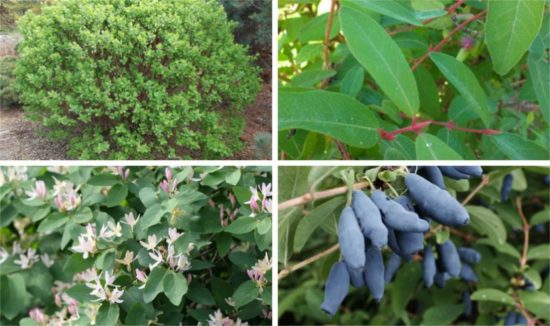
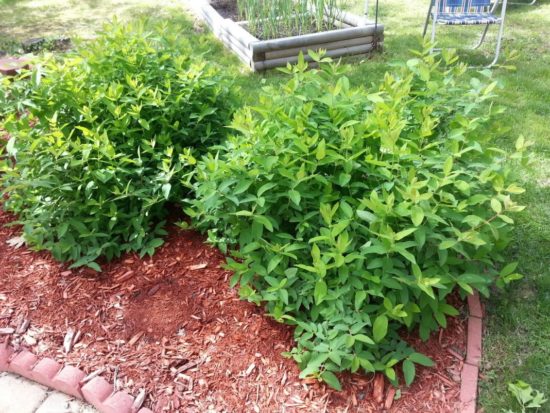
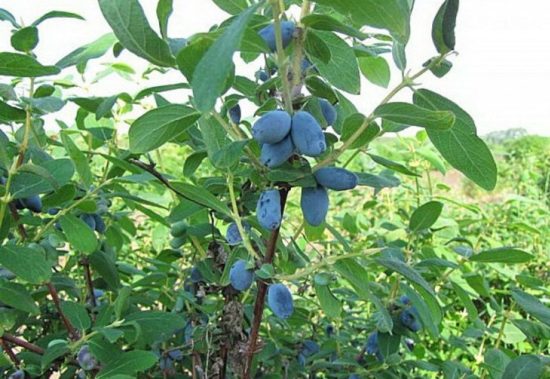


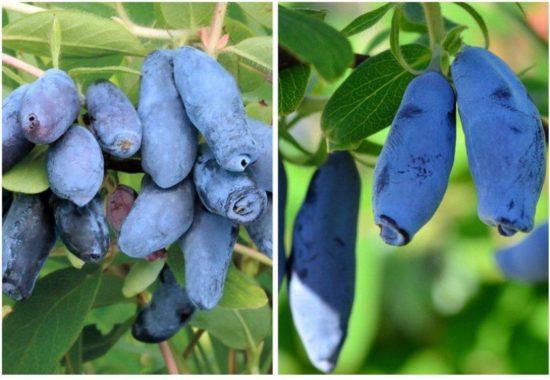
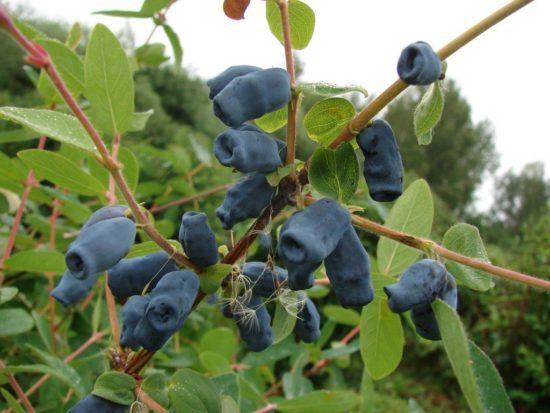
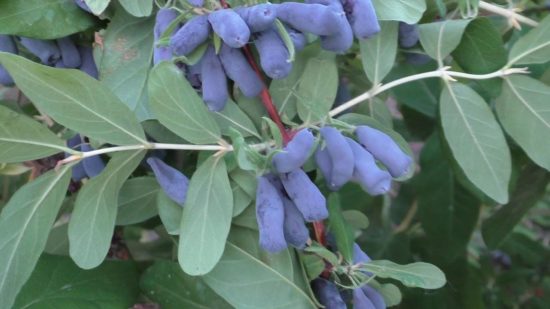

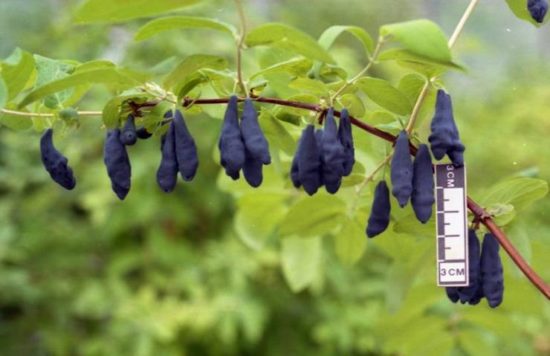
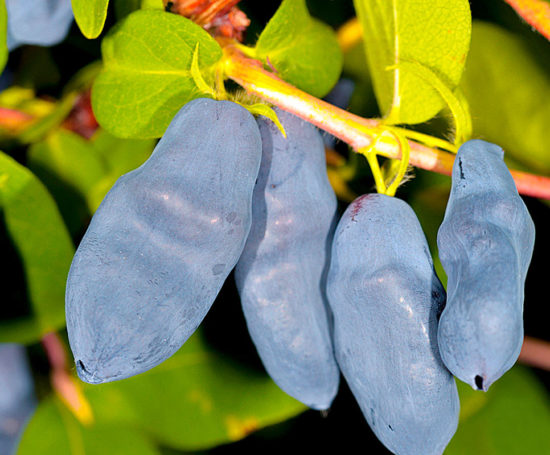
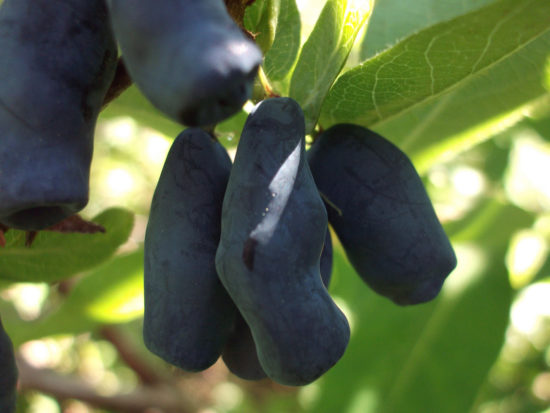
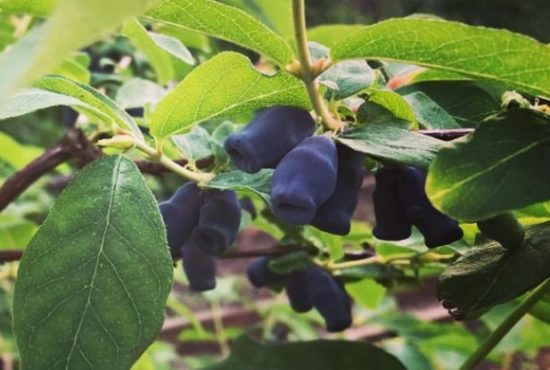
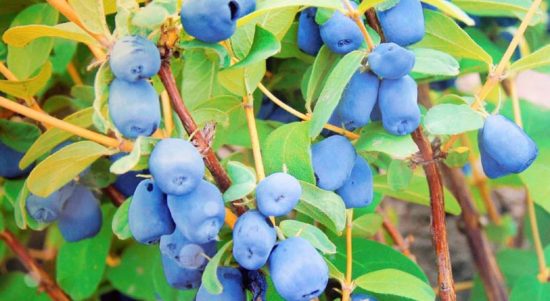
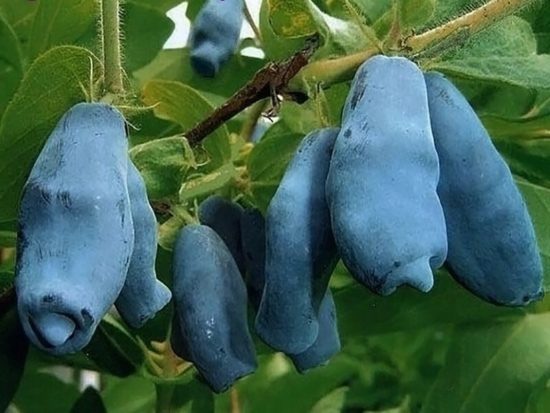
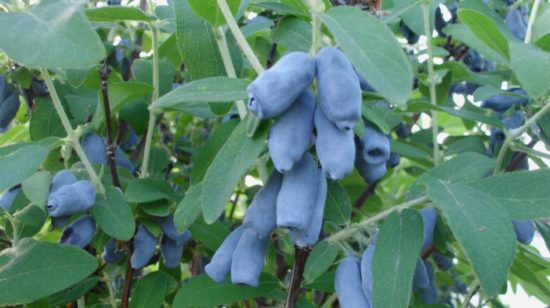
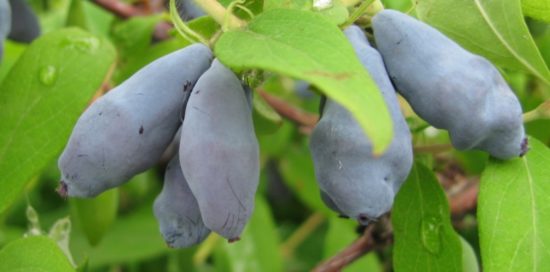
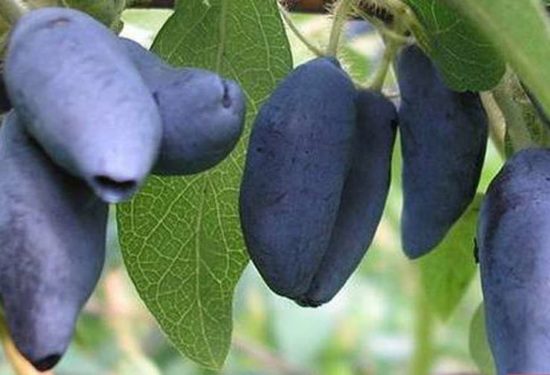
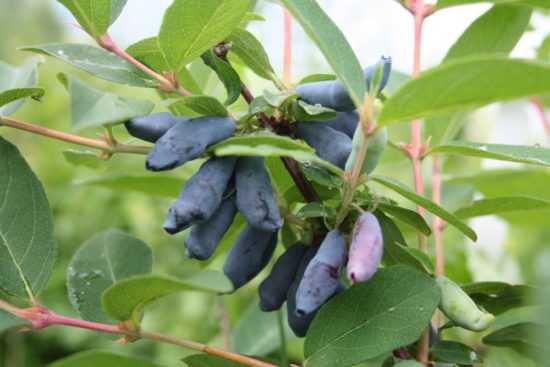
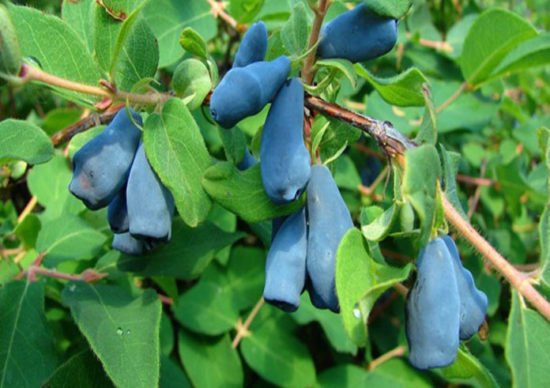
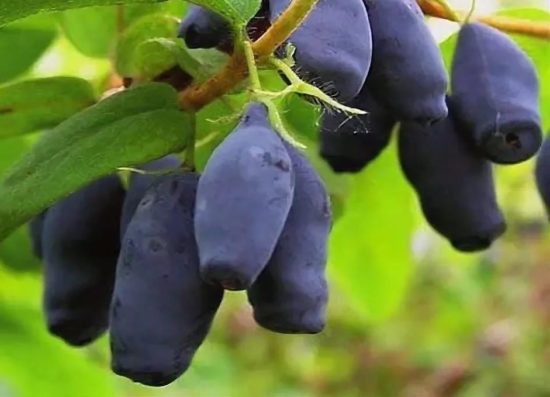
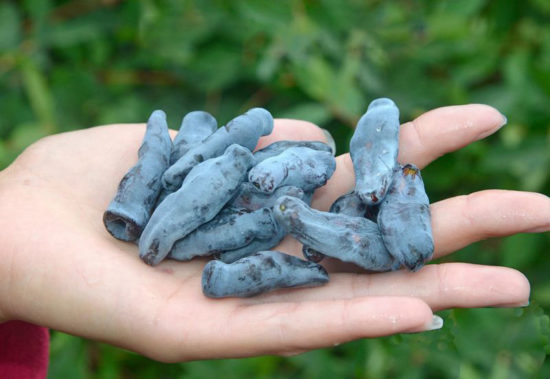
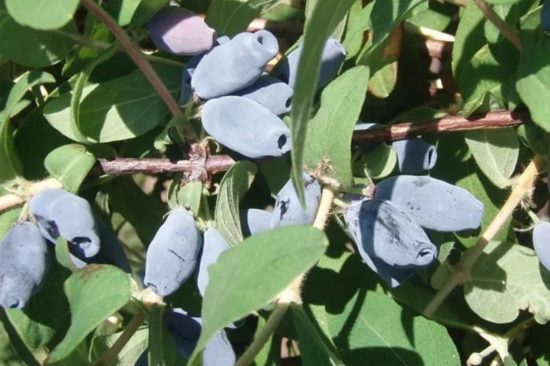
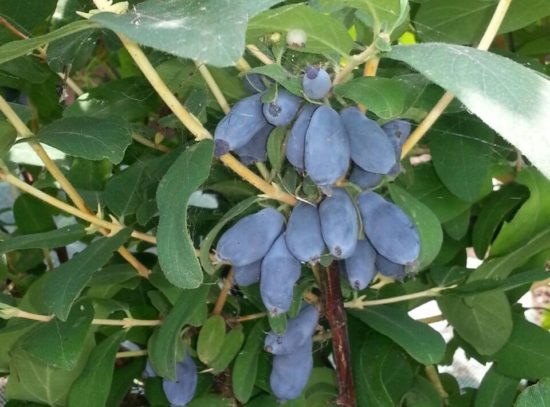


 (5 ratings, average: 3,40 out of 5)
(5 ratings, average: 3,40 out of 5) CUCUMBERS NEVER GET SICK, I'VE BEEN USING ONLY THIS FOR 40 YEARS! I SHARE A SECRET WITH YOU, CUCUMBERS ARE LIKE THE PICTURE!
CUCUMBERS NEVER GET SICK, I'VE BEEN USING ONLY THIS FOR 40 YEARS! I SHARE A SECRET WITH YOU, CUCUMBERS ARE LIKE THE PICTURE! You can dig a bucket of potatoes from each bush. Do you think these are fairy tales? Watch the video
You can dig a bucket of potatoes from each bush. Do you think these are fairy tales? Watch the video
 How our fellow gardeners work in Korea. There is a lot to learn and just fun to watch.
How our fellow gardeners work in Korea. There is a lot to learn and just fun to watch. Eye trainer. The author claims that with daily viewing, vision is restored. They don't charge money for views.
Eye trainer. The author claims that with daily viewing, vision is restored. They don't charge money for views. A 3-ingredient cake recipe in 30 minutes is better than Napoleon. Simple and very tasty.
A 3-ingredient cake recipe in 30 minutes is better than Napoleon. Simple and very tasty. Therapeutic exercises for cervical osteochondrosis. A complete set of exercises.
Therapeutic exercises for cervical osteochondrosis. A complete set of exercises. Which indoor plants match your zodiac sign?
Which indoor plants match your zodiac sign? What about them? Excursion to German dachas.
What about them? Excursion to German dachas.
Seryoga, why do you print articles - after all, all advertising is in print - you want to GET RICH
on advertising???? Try printing it yourself. O T O J.